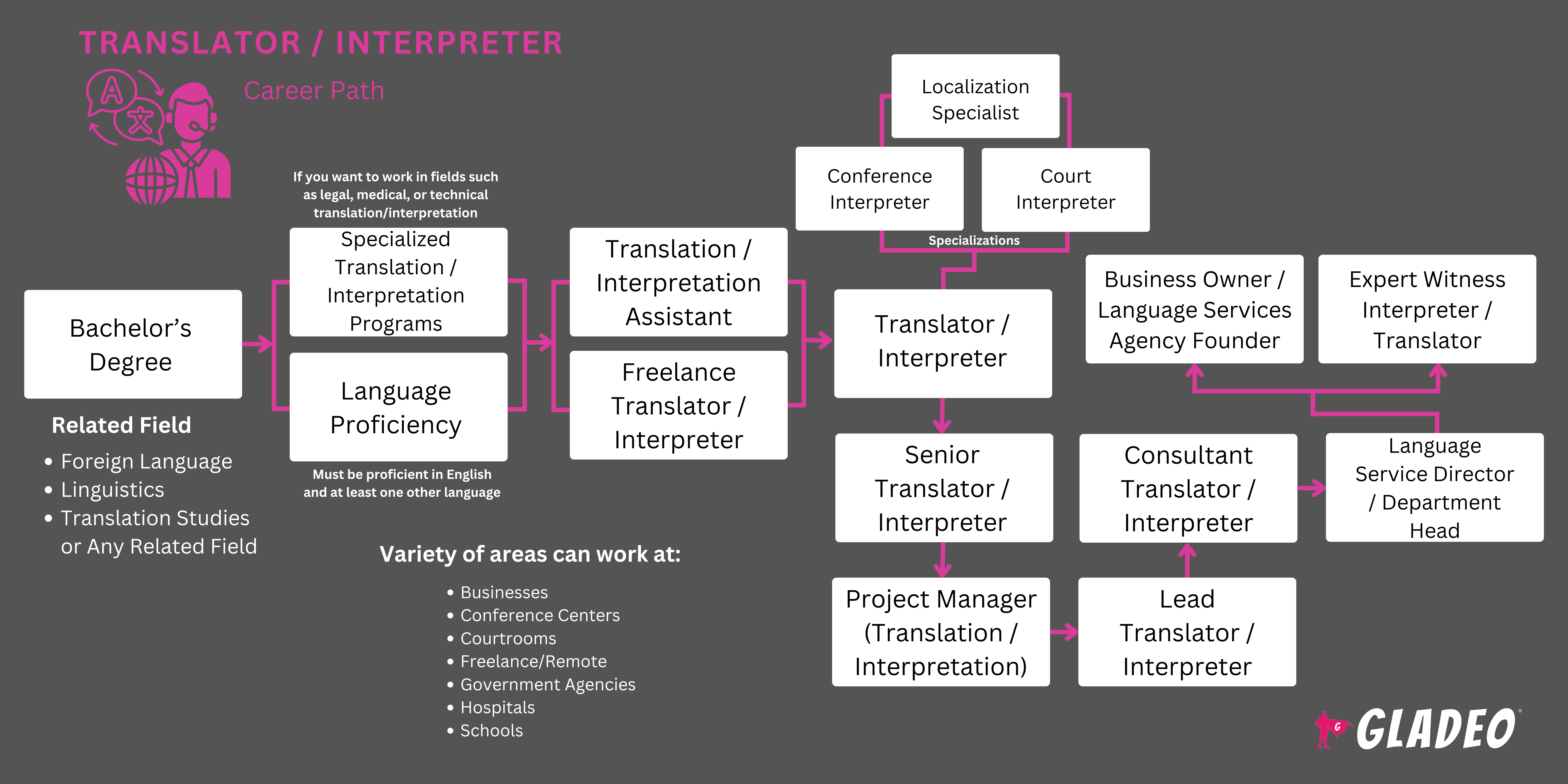聚光灯
美国手语口译员(ASL口译员),法庭口译员,教育口译员,口译员,语言学家,医学口译员,手语口译员,西班牙语口译员,西班牙语翻译员,翻译员
It’s hard to imagine a world without communication—but language barriers can make that a daily challenge. That’s where Translators and Interpreters come in! These language experts help people understand one another by converting words and ideas from one language to another while keeping the original meaning, tone, and cultural context.
Translators work with written materials such as books, legal documents, websites, or subtitles, making sure every sentence is accurate and natural in the target language. Interpreters, on the other hand, deal with spoken language—translating conversations in real time during meetings, medical appointments, or international conferences.
Their work requires more than fluency. Translators and Interpreters must understand cultural nuances, specialized vocabulary, and regional differences in expression. They research, fact-check, and review every detail to ensure clear and professional communication.
Whether helping doctors and patients understand each other, assisting business leaders in international negotiations, or adapting a novel for a new audience, Translators and Interpreters play a vital role in connecting people across cultures and around the world.
- Helping people and organizations communicate clearly across cultures.
- Enabling global collaboration in business, diplomacy, law, and healthcare.
- Gaining exposure to diverse ideas, people, and perspectives.
- Using language skills daily while continuing to learn new terminology and expressions.
- Working independently or traveling internationally for assignments.
工作日程
Translators often work independently or remotely, managing projects and deadlines. Interpreters may have more varied schedules—working in hospitals, courts, conferences, or on-call for emergency services. Freelancers often set their own hours but must balance multiple clients and time zones.
典型职责
- Translate written materials such as reports, contracts, websites, or books.
- Interpret spoken communication between speakers of different languages.
- Proofread and edit translations for accuracy and readability.
- Research cultural references, slang, and context-specific meanings.
- Use translation software and terminology databases.
- Maintain confidentiality, especially in legal or medical settings.
- Work with clients to clarify tone, intent, and technical details.
额外责任
- Specialize in fields like legal, medical, literary, or business translation.
- Prepare subtitles for films or captions for media.
- Train or mentor junior translators.
- Attend international conferences or workshops.
- Keep up with changes in language and technology.
A translator might begin the day reviewing client instructions and researching unfamiliar terms before diving into documents that need careful translation. They may spend hours perfecting phrasing or cross-referencing glossaries to ensure precision.
An interpreter’s day could be more dynamic—translating in real time during a business negotiation, helping a patient communicate with a doctor, or facilitating conversation at a court hearing. Concentration is intense; there’s little room for error.
Both professionals end their day by reviewing notes, checking terminology, and preparing for the next assignment. Every day is a mix of language, culture, and human connection.
软技能
- 文化敏感性
- Excellent memory and listening skills
- Communication and empathy
- Concentration and focus under pressure
- Adaptability and quick thinking
- Ethical discretion and confidentiality
- 注重细节
- 耐心和毅力
技术技能
- Advanced bilingual or multilingual fluency
- Note-taking and shorthand (for interpreters)
- Translation and computer-assisted translation (CAT) software
- Terminology research and documentation
- Knowledge of domain-specific vocabulary (legal, medical, technical)
- Audio and transcription tools
- Proficiency with Microsoft Office or Google Workspace
- Simultaneous Interpreter – Translates speech in real time during conferences or broadcasts.
- Consecutive Interpreter – Listens to a speaker, then conveys the message in the target language after pauses.
- Legal or Court Interpreter – Works in legal settings to ensure defendants, witnesses, and lawyers communicate clearly.
- Medical Interpreter – Helps patients and healthcare professionals understand one another accurately.
- Literary Translator – Adapts novels, poetry, or scripts into other languages while keeping the author’s voice intact.
- Localization Specialist – Adapts websites, software, or video games for international audiences.
- Sign Language Interpreter – Uses sign language to facilitate communication for the Deaf and Hard of Hearing community.
- International organizations (UN, WHO, EU)
- Embassies and government agencies
- Hospitals and healthcare centers
- Law firms and courts
- 学校和大学
- Publishing houses and media companies
- Corporate offices and multinational firms
- Freelance and remote translation agencies
Being a Translator or Interpreter requires intense focus and emotional resilience. Misunderstandings can have serious consequences, especially in legal, diplomatic, or medical settings. Long hours, tight deadlines, and mentally draining sessions are common.
Freelancers may face income fluctuations and must manage their own clients, taxes, and contracts. Interpreters who work on-site might experience travel fatigue or stress from switching languages constantly.
Still, the satisfaction of helping people connect and making global communication possible makes it worth it.
“Without translation, I would be limited to the borders of my own country. The translator is my most important ally. He introduces me to the world.” — Italo Calvino, Italian author
Language services are rapidly evolving thanks to technology. Machine translation and AI tools like DeepL or Google Translate assist human translators, but human nuance and cultural judgment remain irreplaceable.
There’s increasing demand for localization—adapting digital products, apps, and video games for global audiences. Medical and legal interpreting are also growing fields due to migration and international collaboration.
Remote interpreting (via video or phone) has become a standard service, expanding job opportunities worldwide. Multilingual professionals who combine language skills with technology or subject expertise are especially in demand.
People in this career often enjoyed learning new languages, reading books, and watching foreign films or shows. They were curious about different cultures and loved exploring how people express ideas around the world. Many liked word games, writing stories, or helping classmates understand difficult phrases. They probably had a good ear for accents, paid attention to details, and took pride in finding the “perfect word” to say exactly what they meant.
Most Translators and Interpreters hold at least a bachelor’s degree in Translation Studies, Linguistics, Foreign Languages, or a related field. Specialized roles (such as legal or medical interpreting) may require certification or advanced training.
常见的课程主题包括
- Translation Theory and Practice
- Comparative Linguistics
- Advanced Grammar and Composition
- Interpretation Techniques
- Cultural Studies and Cross-Cultural Communication
- Terminology Management
- Computer-Assisted Translation (CAT) Tools
- Ethics and Confidentiality in Language Services
- Technical or Legal Writing
- Public Speaking and Note-taking Skills
- In high school, take foreign language classes—ideally more than one—and aim to reach advanced levels of fluency. English, writing, and communication courses are also valuable for building strong grammar and vocabulary skills.
- Explore language-learning apps like Duolingo or Babbel, or take online courses through Coursera or edX to strengthen your translation and interpretation abilities.
- When choosing a college major, consider programs in Translation Studies, Linguistics, Modern Languages, or Communication that offer real-world practice and cultural immersion.
- Seek internships, part-time jobs, or volunteer opportunities where you can use your language skills—such as community centers, hospitals, law offices, or international organizations.
- Join language clubs, debate teams, or cultural organizations to practice speaking and make connections.
- Attend language workshops, film festivals, or interpreting seminars to stay updated on trends and techniques.
- Read books, watch films, or listen to podcasts in your target language to improve comprehension and pronunciation.
- Create a portfolio that includes sample translations, interpretation recordings, or writing projects to showcase your skills.
- Network with teachers, mentors, or professionals who work in language services.
- Ask supervisors or professors if they can serve as personal references once you’re ready to apply for jobs or internships.
Choose programs accredited by recognized translation or interpretation associations. Look for schools that offer hands-on practice, labs, or internships with government agencies or translation companies.
Programs offering specialized tracks—like legal, medical, or conference interpreting—are valuable for career advancement. Some universities with strong programs include:
- Middlebury Institute of International Studies at Monterey
- University of Geneva – Faculty of Translation and Interpreting
- University of Ottawa – School of Translation and Interpretation
- 蒙特利半岛学院
- New York University – School of Professional Studies

- Visit your school’s career center for help writing your resume, practicing interviews, and identifying language-related job opportunities.
- Apply for entry-level positions, internships, or volunteer roles at translation agencies, government offices, hospitals, or nonprofits that need bilingual support.
- Update your LinkedIn profile to highlight your language skills, certifications, and any volunteer or freelance work you’ve done.
- Network at translation and interpreting events, language expos, and career fairs to meet potential employers or mentors.
- Search job portals like ProZ.com, TranslatorsCafe.com, LinkedIn, Indeed, and Upwork for entry-level translation or interpreting opportunities.
- Look carefully at job postings and include relevant keywords in your resume, such as:
- Translation
- Interpretation
- Localization
- Terminology Management
- Bilingual Communication
- Proofreading
- Editing
- CAT Tools (e.g., Trados, MemoQ)
- Simultaneous or Consecutive Interpreting
- Technical or Legal Translation
- Review translator and interpreter resume samples to get formatting ideas.
- Practice common interview questions about language proficiency, cultural awareness, and accuracy under pressure.
- Stay informed about translation technologies and language trends so you can discuss them confidently.
- Dress professionally and bring samples of your work if requested—they help demonstrate your attention to detail and communication skills!
- Earn advanced certifications in specialized fields (medical, legal, or conference interpreting).
- Master additional languages to widen your client base.
- Build expertise in niche industries like IT, law, or healthcare.
- Publish translated works or academic papers in translation studies.
- Lead workshops or teach translation and interpretation courses.
- Develop skills in localization and transcreation for digital industries.
- Join international organizations such as AIIC or FIT (Fédération Internationale des Traducteurs).
- Become a senior interpreter, project manager, or consultant for international firms.
- Stay updated on AI and translation technologies to remain competitive.
网站
- American Translators Association (ATA.org)
- ProZ.com
- TranslatorsCafe.com
- International Association of Conference Interpreters (AIIC.net)
- National Association of Judiciary Interpreters and Translators (NAJIT.org)
- LanguageLine.com
- O*NET OnLine
- CareerOneStop.org
书籍
- Found in Translation by Nataly Kelly and Jost Zetzsche
- Is That a Fish in Your Ear? by David Bellos
- In Other Words by Mona Baker
- The Translator’s Invisibility by Lawrence Venuti
- Thinking Translation by Sandor Hervey, Ian Higgins, and Louise M. Haywood
Language services are evolving quickly thanks to advances in artificial intelligence and machine translation tools. There will still be plenty of work for Translators and Interpreters in the future, but the nature of the job is changing. Instead of being replaced, professionals in this field will need to adapt—using technology as a tool while focusing on the human elements that machines can’t replicate, like tone, context, and cultural nuance.
想了解具有相关技能的类似职业选择吗?请查看下面的列表!
- Foreign Language Teacher
- 技术撰稿人
- Diplomatic Officer
- Editor or Proofreader
- Cultural Liaison
- Localization Project Manager
- Tour Guide or Travel Consultant
- 公共关系专家
点击这里下载信息图
新闻联播

特色工作

在线课程和工具

年薪预期
New workers start around $49K. Median pay is $64K per year. Highly experienced workers can earn around $92K.





